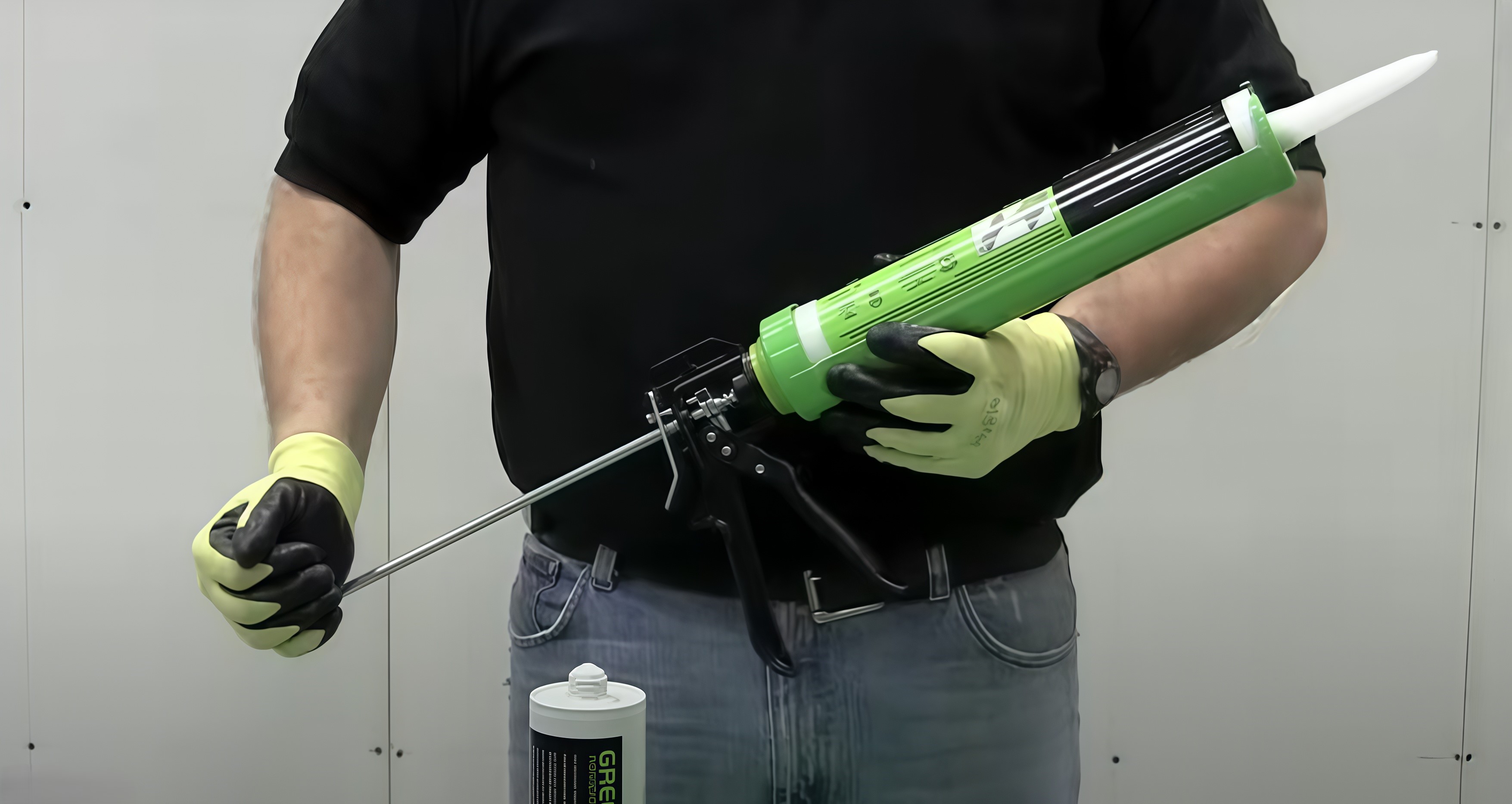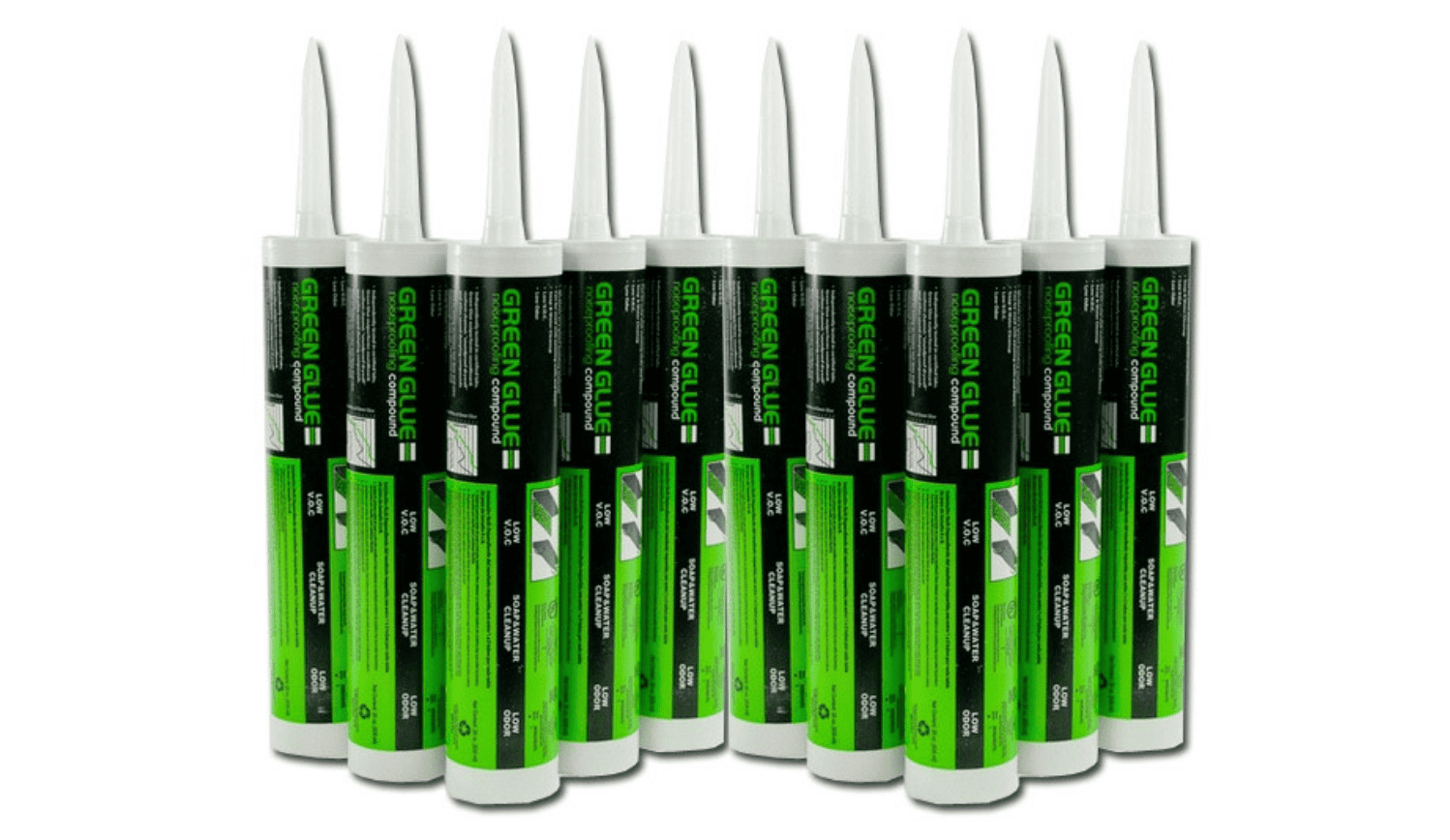
When people start learning about soundproofing, they often imagine thick insulation, heavy drywall, or acoustic panels. But what surprises many is that one of the most effective materials for blocking sound isn't a wall covering — it's a thin layer of a green, gel-like compound that goes between walls. That's Green Glue, a product trusted by builders, studio engineers, and architects around the world.
At Sound Pro Solutions, we've used Green Glue for years in residential, commercial, and recording environments. It's simple to apply, cost-effective, and incredibly powerful at reducing noise transmission. So let's break down what it actually is, how it works, and why professionals love it.
What Is Green Glue Soundproofing Compound
In short, Green Glue is a sound-damping compound designed to reduce vibration and sound transfer between solid surfaces. It's not an adhesive in the traditional sense — it doesn't permanently glue two panels together. Instead, it acts as a flexible, viscoelastic layer that converts sound energy into heat.
When you sandwich it between two layers of drywall, plywood, or subflooring, it creates a cushion that prevents vibrations from passing directly from one layer to the other. The result? Massive reduction in sound transmission.
Professionals often describe it as the "missing layer" in modern construction — that one step that takes a standard wall and turns it into an acoustically controlled barrier. For anyone wondering what Green Glue soundproofing is, it's essentially the secret ingredient to building quiet spaces without major reconstruction.
The Difference Between Green Glue and Regular Construction Adhesives
A common mistake we see is people confusing Green Glue with regular adhesive. Traditional construction glue hardens into a rigid bond, which is great for strength but terrible for sound isolation. Rigid materials transmit vibrations easily.
Green Glue, however, stays flexible. It's made to remain slightly elastic even after curing, which allows it to absorb vibration instead of transferring it. In soundproofing terms, it acts like a shock absorber for noise.
So if you're comparing Green Glue noiseproofing compound to something like Liquid Nails or standard drywall adhesive, the difference is night and day. One bonds surfaces firmly, the other isolates them acoustically. And in the world of soundproofing, flexibility beats rigidity every time.
Why It Changed the Soundproofing Industry
Before Green Glue came along, builders relied on bulky methods to block sound — double walls, decoupled studs, or expensive floating floors. These approaches worked, but they were costly, space-consuming, and often impractical for small projects.
Green Glue changed that. It made high-performance soundproofing accessible to homeowners, contractors, and DIYers alike. By applying it between drywall sheets, you could achieve results similar to complex studio-grade walls — but at a fraction of the cost and labor.
Today, it's used in homes, hotels, hospitals, and even recording studios. Its ability to reduce both airborne and structure-borne noise makes it one of the most versatile materials in the industry. And for us at Sound Pro Solutions, it's a go-to component in nearly every custom soundproofing plan.
What Is Green Glue Made Of
The exact formula is proprietary, but we know the basics. Green Glue is made of a viscoelastic polymer compound, which means it behaves partly like a liquid and partly like a solid. That hybrid nature is what allows it to absorb energy from sound waves and dissipate it as heat.
It contains no solvents or harmful chemicals, making it safe for residential use. There's no strong odor, and it cleans up easily with soap and water. It's also non-toxic and environmentally friendly, which is a big reason it's so popular among contractors and eco-conscious builders.
For anyone asking what Green Glue is made of, the short answer is this: it's a carefully engineered polymer designed to stop sound energy dead in its tracks — safely and efficiently.
How Does Green Glue Work to Block Sound
The science behind it is fascinating, but easy to understand. When sound hits a wall, it creates tiny vibrations that pass through solid surfaces. Normally, those vibrations travel directly through drywall, studs, and into the next room.
But when Green Glue is applied between layers, it disrupts that motion. The compound moves slightly as the sound wave passes, turning that vibration into heat through friction. The energy doesn't disappear — it's simply converted into something harmless.
The effect is measurable and dramatic. Independent lab tests show that walls treated with Green Glue can reduce sound transmission by up to 10 decibels or more, depending on construction type. In acoustic terms, that's the difference between hearing your neighbor's TV clearly and barely noticing it's on.
If you've ever wondered how does Green Glue work, think of it as a shock absorber for your walls — soft enough to move with sound, strong enough to stop it cold.
What Is Green Glue for Drywall Applications

One of the most common uses for Green Glue is between two layers of drywall. It's the easiest, most efficient way to improve a wall's Sound Transmission Class (STC) rating — basically, how well a wall blocks sound.
Here's how it works in practice: you apply Green Glue directly to the back of a new drywall sheet using a standard caulking gun or bulk applicator. Then, you press that sheet onto an existing wall or ceiling and screw it in place. Within seconds, you've transformed an ordinary partition into a high-performance sound barrier.
This is why contractors and studio builders swear by it. For homeowners, it's the perfect solution when you want to quiet a noisy bedroom, home office, or shared wall without tearing down the structure. Green Glue adds only about 1/8 of an inch to total wall thickness but delivers results that feel like an entirely new build.
If you're curious what is Green Glue for drywall, it's not an adhesive in the traditional sense — it's an acoustic layer that decouples drywall panels and turns vibration into silence.
Common Questions About Using Green Glue
At Sound Pro Solutions, we often get questions from customers trying Green Glue for the first time. It's easy to apply, but understanding how it behaves helps you get the best results. Let's tackle a few of the most common ones.
Can You Use Green Glue on Existing Walls?
Yes, you can. You don't need to demolish anything. The simplest method is to add a second layer of drywall directly over the existing one, applying Green Glue between them. This instantly improves sound insulation without affecting your décor.
It's also a great choice for renters or businesses upgrading soundproofing in finished spaces — it's fast, clean, and requires minimal disruption.
How Long Does Green Glue Take to Cure?
While Green Glue begins damping vibration immediately after installation, it takes time to fully reach peak performance. Typically, the curing process lasts about 30 days, though you'll notice improvement within just a few days.
During that time, the compound continues to spread and settle between layers, optimizing its flexibility. Once cured, it maintains its damping ability for decades without degrading or hardening.
Patience pays off here — the longer it sits, the quieter your wall becomes.
Does Green Glue Work on Its Own Without Other Materials?
That's one of the biggest misconceptions. Green Glue is incredibly effective, but it's not a magic fix. It must be part of a complete soundproofing system to reach its full potential.
If you apply it between thin, hollow-core panels, you'll still hear sound transfer. Pair it with dense materials — like 5/8" drywall, rockwool insulation, or mass-loaded vinyl (MLV) — and the results are outstanding.
Think of Green Glue as the connector that makes other materials work together more efficiently. It doesn't replace mass or insulation; it amplifies their performance by reducing vibration.
So if you've ever wondered whether Green Glue noiseproofing compound can work on its own, the answer is no — but as part of a layered system, it's unbeatable.
Professional Tips for Getting the Most from Green Glue
After years of real-world testing, our team at Sound Pro Solutions has learned a few insider tricks to make your Green Glue installation even more effective:
- Apply generously but evenly. Two tubes per 4x8' drywall sheet is the standard. Spread it in random patterns — there's no need to cover every inch.
- Work quickly. You have about 15 minutes before the compound starts to set. Apply it and install the panel immediately.
- Seal the perimeter. Use acoustic caulk around the edges to close any gaps. Sound loves to escape through cracks.
- Combine layers. For the best results, use Green Glue with double drywall and sound insulation between studs.
- Be patient. Remember the curing period — full performance develops over several weeks.
Green Glue remains one of the most cost-effective solutions for reducing noise without complex construction. It's trusted by professionals because it's consistent, safe, and proven to work in virtually any building type — from apartments to studios to offices.
If you're ready to try it, explore our soundproofing materials and application accessories on soundprosolutions.com. We provide fast U.S. shipping, simple returns, and expert guidance every step of the way.
Quiet walls aren't complicated — they just need the right layers, the right approach, and the right products. And Green Glue is the place to start.
Recent posts




